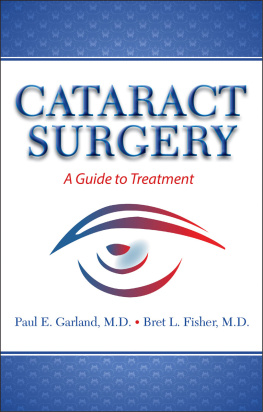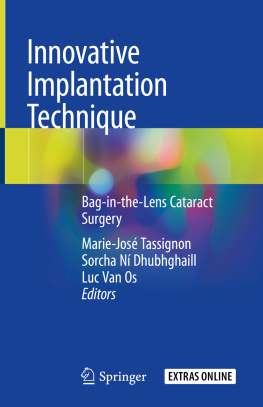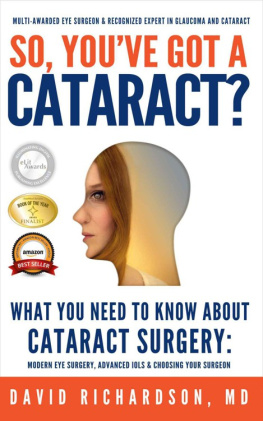An Addicus Nonfiction Book
Copyright 2015 by Addicus Books, Inc. All rights reserved. No part of this publication may be reproduced, stored in a retrieval system, or transmitted in any form or by any means, electronic, mechanical, photocopied, recorded, or otherwise, without the prior written permission of the publisher. For information, write Addicus Books, Inc., P.O. Box 45327, Omaha, Nebraska 68145. Cover and interior design by Jack Kusler
This book is not intended to be a substitute for a physician, nor do the authors intend to give advice contrary to that of an attending physician.
Addicus Books, Inc.
P.O. Box 45327
Omaha, Nebraska 68145
www.AddicusBooks.com
Printed in the United States of America
10 9 8 7 6 5 4 3 2 1
Contents
Introduction
I f youve just learned that you have a cataract, you may be apprehensive about what happens next. Rest assured, cataracts are a very common eye problem, typically related to normal aging. Were all likely to experience cataractsthe clouding of the eyes lens. Fortunately, the vast majority of people who suffer from cataracts today can undergo successful outpatient surgery to treat them. In many cases, physicians can remove the cataracts and improve vision problems such as nearsightedness, farsightedness, or even astigmatism.
As cataract surgeons, we want to help our patients make informed decision about their cataract treatment. We wrote this book to help you understand how cataracts are removed and how your visual clarity is restored. We explain advances in technology and techniques that have made cataract surgery the most commonly performed operation in the United States. We hope that Cataract Surgery educates you about how cataracts are removed as well as give you peace of mind about your surgical procedure.
Cataracts: An Overview
A ge-related cataracts are common. Most of us will develop them as we grow older. The American Academy of Ophthalmology suggests that by age seventy-five, 70 percent of adult Americans will experience the blurring and distorted vision associated with cataracts. Statistics suggest that by the year 2020, cataracts will affect more than 30 million Americans, a considerably higher number than the 20 million adults affected today.
But what exactly is a cataract? What are the symptoms? And what puts you at risk for developing them? Its important that you pay attention to cataracts once they start developing because they can gradually, but significantly, reduce your vision and even cause blindness. The good news is that, thanks to modern medicine, cataracts are very treatable, and impaired vision can be restored.
What Is a Cataract?
The term cataract has ancient roots in the Greek and Latin terms for waterfall. Thats because centuries ago people believed the clouding in their eyes actually came from an opaque material flowing like water over their eyes. Indeed, a cataract is a clouding of the eye lens. As the cloudiness increases, the cataract can blur or distort your vision and cause colors to fade. If not treated, cataracts can lead to blindness. Most cataracts are related to normal aging, but they also can result from other issues such as trauma, sun exposure, or diseases. To understand how any cataract forms, its helpful to understand the makeup of the lens of your eyeball. The lens is made up mostly of protein and water. The protein is arranged in such a way that when light passes through it to get to the retina, it does so without distortion.
Eye Anatomy

As people age, however, changes in the eye cause protein to break down and clump together, creating a buildup that hardens and blurs your vision. More specifically, the lens thickens, becoming less flexible and transparent. At first, the clouding involves a small area, but over time it increases in size, density, and color, eventually engulfing the entire lens. Your vision is affected because the clumping scatters light coming through the lens in such a way that a sharply defined image cant reach the retina. Your lens no longer has the ability to adjust appropriately to see up close or far away. Instead, everything you see is faded, distorted, or blurred.
How the Eye Works

The human eye works much like a camera. In a camera, an image passes through the lens and strikes the film, where it is imprinted into the film. In the eye, an image passes through the lens onto the retina. The image message travels through the optic nerve to the brain, where it is interpreted.
Types of Cataracts
Eye surgeons have different ways of classifying cataracts based on their location within the lens. The three basic types are nuclear, cortical, and subcapsular, as explained in the text that follows.
Other types of cataracts, which are not caused by aging, are named according to their underlying origin. For example, these include congenital and traumatic cataracts.
Nuclear Cataracts
Nuclear cataracts are the most common type of cataract. They form in the center, or nucleus, of the eye. They can start forming when youre only in your forties or fifties, but they usually dont significantly affect vision until youre in your sixties and seventies. In fact, by age seventy most men and women have some degree of clouding. Nuclear sclerotic cataracts cause yellow tinting that can eventually harden into a dense yellow or brownish yellow center. Vision gradually deteriorates with symptoms ranging from blurring and seeing halos around objects to having difficulty in distinguishing color or contrasts.
Cortical Cataracts
Cortical cataracts develop along the edge (cortex ) of the lens. They begin as streaks of whitish, wedge-shaped growths that eventually extend, like the spokes of a wheel, from the edge into the center of the lens. Because of this pattern, light tends to scatter when it hits the lens, causing initial problems with glare. Although older adults can develop cortical cataracts, theyre a common problem in diabetics of all ages.
Posterior Subcapsular Cataracts
Posterior subcapsular cataracts form at the back of the lens, directly below the pocket or membrane that surrounds the lens. These cataracts begin as small cloudy areas blocking the path of light to the retina, causing light to scatter rather than remain focused. Symptoms include trouble seeing close-up for reading and sensitivity to bright light, causing severe glare. These cataracts tend to develop relatively quickly, in months rather than years. Although posterior subcapsular cataracts can be related to aging, theyre more commonly associated with diabetes and prolonged use of prednisone or other prescription steroids. And, they tend to be seen in younger patients.
Nuclear Cataract

A nuclear cataract is the most common type of cataract. It can cloud the entire lens
Cortical Cataract

Next page
















